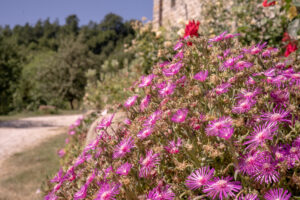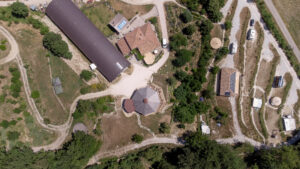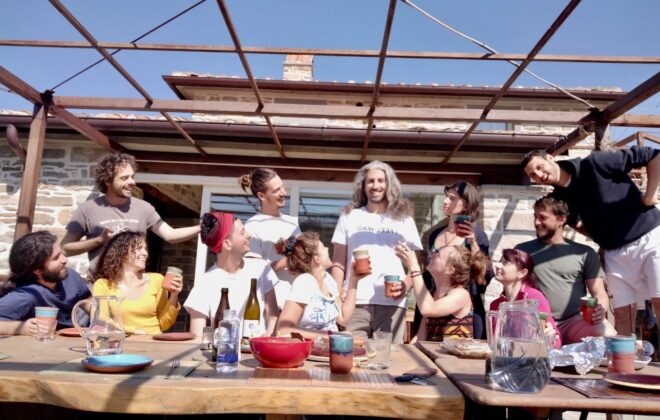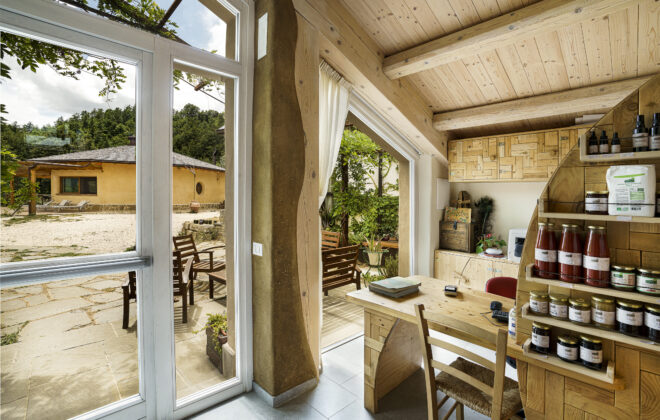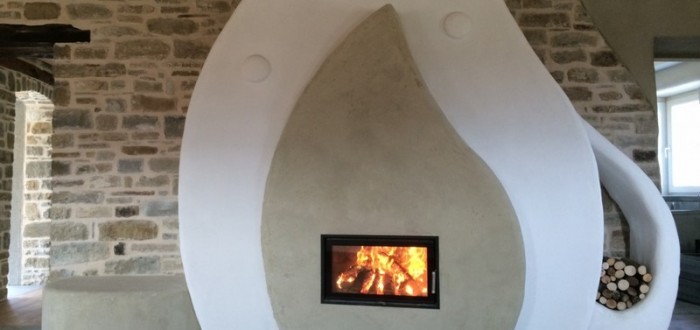The Way of Doing
Food and energy self-sufficiency and sustainability in practice until 2050: here’s how it’s done
INTERVIEW WITH FRANCESCO ROSSO | DIRECTOR OF MACROLIBRARSI AND FOUNDER OF LA FATTORIA DELL’AUTOSUFFICIENZA
At the end of November 2021, a new documentary was published on La Fattoria dell’Autosufficienza YouTube channel showing how the project was born, has grown and is evolving.
La Fattoria dell’Autosufficienza is a centre for applied ecology, hospitality and education designed in a totally sustainable way according to permaculture principles. It is a place of extraordinary biodiversity and beauty and has been designed to function self-sufficiently from today and for the next seven generations. At the Farm you can experience first-hand how it is possible to live in harmony and alliance with the principles and rhythms of Nature.
Following the publication of the video, we received many questions. Many of you asked us: “But how do you achieve all this?”; but also many objections: “It is impossible for everyone to start living like this!”.
To answer them, we turned your questions over to Francesco Rosso, administrator of Macrolibrarsi, creator and founder of La Fattoria dell’Autosufficienza.
Francesco, the new documentary shows the farm in all its glory: biodiversity, permaculture, energy and food self-sufficiency. A small group of people who are realising the change they want to see in the world. How did it all come about?
Many people ask me this question and unfortunately I do not have a repeatable recipe. It is almost impossible for such a project to be repeated with the same initial ingredients, although it is a testimony that anything is possible when there is a strong focus and perseverance.
In 2009, as a family, we purchased 70 hectares of abandoned land with dilapidated ruins. After the purchase investment was completed, we had exhausted 100 per cent of the financial resources we possessed at that time. I hoped to be able to carry out the first renovations with public aid, unfortunately for nine years nothing was accessible.
I soon realised that I would have to initially grow the project with little economic funds and especially despite my great inexperience. I was 24 years old at the time, with no skills or knowledge in agriculture, let alone construction. So we started off in small steps, buying only the necessary equipment, using makeshift structures such as a yurt and prefabricated wooden houses. As the project grew, as I gained knowledge and experience, the financial possibilities also grew, thanks to Macrolibrarsi, the company I was following – and still follow – in parallel and which made it possible to finance the first major renovation, which began only five years after the initial purchase.
So without Macrolibrarsi’s financial help, the project would not have been possible?
I think the project would have gone ahead in other ways. The renovation might have been slower, but funding would still have arrived in different forms: other partners would have participated in the project, public funding, crowdfounding… who knows.
Many people think that in order to realise structures of this kind you necessarily need either great liquidity or collateral assets, but in reality very few projects come about with these assumptions. By this I do not mean that money is not needed or has not been needed to realise the Farm project, but that when the project is good and there are people ready to spend to realise it, the money comes in one way or another.
There are many examples of this – italiachecambia.org collects stories of this kind: many people and groups have created a reality similar to ours and almost all of them started with very little money in the bank, but with a very clear dream in their hearts.
Would you advise everyone to embark on a path similar to yours?
Not to everyone. Motivation must be really high. You have to love what you are going to do, because the initial difficulties are so many – and they are not just economic, as many people believe. So many people today want to set up a self-sufficient farm because they are escaping from the chilling social reality they experience in the city.
Recovering ruins and abandoned land is extremely challenging; it is a life project. Before embarking on such an adventure, one should ask oneself: “If the economic, social, environmental circumstances had not changed…is this the path I would have taken anyway?”
If the answer is no, you will most likely fail.
The Farm stands as a model to follow. Isn’t it unthinkable that 8 billion people would embark on such a path? Surely there is not enough land for everyone?
Without getting into the controversial subject of how many people should live on Earth, as of today Italy is still full of abandoned land and ruins in every region. When will every piece of land ever be transformed into a productive paradise of organic food, then we will ask ourselves the question. Today those who flaunt the lack of land do so only as an excuse to maintain the status quo.
Many in the comments to the video ask if it is possible to move to the farm or otherwise participate in the project…
Today, La Fattoria dell’Autosufficienza is still a production, training and tourist accommodation centre. In these first years, we are focused on creating economic self-sufficiency, food and energy self-sufficiency, but also in terms of health and education.
At the moment, we do not have any accommodation facilities that we can devote to housing, other than those for the people who already live and work in the project.
In the coming years we will also create a residential area that we hope will evolve into an ecovillage and a complete model of living, together with the production centre. However, we still lack the premises, so we are not an ecovillage and it is not possible to move to the farm.
But neither is it possible to have a time-limited experience?
We are members of Wooof Italia, an association that links volunteers and natural rural projects, promoting educational and cultural experiences to help build a sustainable global community. In this way, every year we host dozens of volunteers who experience the Farm with us for a period of at least one month and in some cases for several years.
Aren’t you thinking of setting up other Farms or helping others in the implementation?
Although we have made a lot of progress, our project is still at a very early stage of development. There is never enough time to be able to do everything we set our sights on, it is unthinkable that we could dedicate ourselves to other projects.
Is there any advice you would like to give to people who are about to embark on a rural, self-sufficient living project?
Arm yourself with great patience. Take plenty of time to observe and plan, but give yourself a deadline in which to start doing. Remember that Nature is not at all kind and is never responsible for what does not work. Secure a harvest now, but also sow seeds for the next seven generations.
WATCH
The documentary on La Fattoria dell’Autosufficienza, a project of Macrolibrarsi.it
macrogo.to/docu-fattoria
This article appeared in magazine Vivi Consapevole 68 (March/May 2022).
Tags In
Related Posts
La Via del Fare
Autosufficienza alimentare, energetica e sostenibilità in pratica fino al 2050: ecco come si fa
INTERVISTA A FRANCESCO ROSSO | DIRETTORE DI MACROLIBRARSI E FONDATORE DELLA FATTORIA DELL’AUTOSUFFICIENZA
A fine novembre 2021 è stato pubblicato sul canale YouTube della Fattoria dell’Autosufficienza un nuovo documentario che mostra com’è nato, cresciuto e si sta evolvendo il progetto.
La Fattoria dell’Autosufficienza è un centro di ecologia applicata, ospitalità e formazione progettata in maniera totalmente sostenibile secondo i principi della permacultura. È un luogo di straordinaria biodiversità e bellezza ed è stato pensato per funzionare in maniera autosufficiente da oggi e per le prossime sette generazioni. Alla Fattoria puoi toccare con mano come sia possibile vivere in armonia e alleanza con i principi e i ritmi della Natura.
In seguito alla pubblicazione del video ci sono arrivate tantissime domande. In tanti ci avete chiesto: «Ma come si fa a realizzare tutto questo?»; ma anche tante obiezioni: «È impossibile che tutti iniziamo a vivere così!».
Per rispondere, abbiamo girato le vostre domande a Francesco Rosso, amministratore di Macrolibrarsi, ideatore e fondatore della Fattoria dell’Autosufficienza.
Francesco, il nuovo documentario mostra la Fattoria in tutto il suo splendore: biodiversità, permacultura, autosufficienza energetica e alimentare. Un piccolo gruppo di persone che sta realizzando il cambiamento che vuole vedere nel mondo. Com’è stato possibile realizzare tutto ciò?
In tanti mi pongono questa domanda e purtroppo non ho una ricetta ripetibile. È quasi impossibile che un progetto simile possa ripetersi con gli stessi ingredienti iniziali, anche se è la testimonianza che tutto è possibile quando ci sono una forte focalizzazione e perseveranza.
Nel 2009 come famiglia abbiamo acquistato 70 ettari di terreni abbondonati con ruderi fatiscenti. Terminato l’investimento d’acquisto avevamo esaurito il 100% delle risorse economico-finanziarie che possedevamo in quel momento. Speravo di poter portare avanti le prime ristrutturazioni grazie ad aiuti pubblici, purtroppo per nove anni non c’è stato nulla di accessibile.
Ben presto mi resi conto che avrei dovuto far crescere inizialmente il progetto con pochi fondi economici e soprattutto nonostante la mia grande inesperienza. Allora avevo 24 anni, nessuna abilità e conoscenza in ambito agricolo e tanto meno edile. Siamo partiti quindi a piccoli passi, acquistando solo l’attrezzatura indispensabile, utilizzando strutture di fortuna come una Yurta e delle casette prefabbricate di legno. Man mano che il progetto cresceva, che acquisivo conoscenza ed esperienza, sono cresciute anche le possibilità finanziarie grazie a Macrolibrarsi, l’azienda che seguivo – e che ancor oggi seguo – parallelamente e che ha permesso di finanziare la prima importante ristrutturazione, iniziata solo cinque anni dopo l’acquisto iniziale.
Senza l’aiuto economico di Macrolibrarsi non sarebbe quindi stato possibile realizzare il progetto?
Penso che il progetto sarebbe andato avanti in altre modalità. La ristrutturazione forse sarebbe stata più lenta, ma sarebbero comunque arrivati finanziamenti in diversa forma: altri soci che avrebbero partecipato al progetto, finanziamenti pubblici, crowdfounding… chi lo sa.
Molte persone pensano che per realizzare strutture di questo tipo siano per forza necessari o grande liquidità o comunque dei beni di garanzia, ma nella realtà dei fatti pochissimi progetti nascono con questi presupposti. Con questo non voglio dire che non servono i soldi o non sono serviti i soldi per realizzare il progetto della Fattoria, ma che quando il progetto è valido e ci sono le persone pronte a spendersi per realizzarlo, i soldi in un modo o nell’altro arrivano.
Ci sono tanti esempi al riguardo – italiachecambia.org raccoglie storie di questo tipo: molte persone e gruppi hanno creato una realtà simile alla nostra e quasi tutti sono partiti con pochissimi soldi in banca, ma con un sogno molto chiaro nel cuore.
Consiglieresti a tutti di intraprendere un percorso simile al tuo?
Non a tutti. La motivazione deve essere veramente alta. È necessario amare ciò che si sta andando a fare, perché le difficoltà iniziali sono tantissime – e non sono solo economiche, come in tanti credono. Oggi tantissime persone vogliono realizzare una fattoria autosufficiente perché scappano da una realtà sociale agghiacciante che vivono in città.
Recuperare ruderi e terreni abbandonati è estremamente impegnativo, è un progetto di vita. Prima di mettersi in un’avventura di questo tipo bisognerebbe chiedersi: «Se non fossero cambiate le circostanze economiche, sociali, ambientali…è il percorso che avrei comunque intrapreso?».
Se la risposta è no, molto probabilmente fallirai.
La Fattoria si pone come un modello da seguire. Non è impensabile che 8 miliardi di persone intraprendano un percorso simile? Non ci sono certamente sufficienti terreni per tutti…
Senza entrare nel controverso tema di quante persone dovrebbero vivere sulla Terra, ad oggi l’Italia è ancora piena di terreni e ruderi abbandonati in ogni regione. Quando mai ogni fazzoletto di terra sarà trasformato in un paradiso produttivo di cibo biologico, allora ci porremo il problema. Oggi chi sbandiera la mancanza di terra lo fa solo come scusa per mantenere lo status quo.
Tanti nei commenti al video chiedono se è possibile trasferirsi in Fattoria o comunque
partecipare al progetto…
Oggi La Fattoria dell’Autosufficienza è ancora un centro produttivo, di formazione e di ospitalità turistica. In questi primi anni siamo concentrati nel creare autosufficienza economico-finanziaria, autosufficienza alimentare ed energetica, ma anche in termini di salute ed educazione.
Non abbiamo al momento strutture ricettive da poter dedicare alla residenzialità, oltre a quelle per le persone che già vivono e lavorano al progetto.
Nei prossimi anni creeremo anche una zona residenziale che ci auguriamo possa evolvere in ecovillaggio e modello completo di vita, unitamente al centro produttivo. Ancora però mancano le premesse, quindi non siamo un ecovillaggio e non è possibile trasferirsi in Fattoria.
Ma non è possibile neanche fare un’esperienza limitata nel tempo?
Siamo soci di Wooof Italia, un’associazione che mette in relazione volontari e progetti rurali naturali, promuovendo esperienze educative e culturali per contribuire a costruire una comunità globale sostenibile. In questo modo ogni anno ospitiamo decine di volontari che vivono la Fattoria insieme a noi per un periodo di minimo un mese e in alcuni casi anche per diversi anni.
Non state pensando di creare altre Fattorie o di aiutare altri nella realizzazione?
Per quanto abbiamo fatto tantissimi passi avanti il nostro progetto è ancora in una fase di grande sviluppo. Il tempo non è mai sufficiente per riuscire a fare tutto ciò che ci diamo come obiettivo, impensabile poterci dedicare anche altri progetti.
C’è un consiglio che vuoi dare a chi sta per intraprendere un progetto di vita rurale ed autosufficiente?
Armati di grande pazienza. Prenditi tanto tempo per osservare e per progettare, ma datti una scadenza nella quale iniziare a fare. Ricorda che la Natura non è per nulla gentile e non ha mai la responsabilità per ciò che non funziona. Assicurati subito un raccolto, ma semina anche per le prossime sette generazioni.
GUARDA
Il documentario sulla Fattoria dell’Autosufficienza, un progetto di Macrolibrarsi.it
macrogo.to/docu-fattoria
Questo articolo è apparso sulla rivista Vivi Consapevole 68 (marzo/maggio 2022).
Tags In
Newsletter
ARGOMENTI
- Activities (8)
- Attività (10)
- Attrattive (16)
- Cosa fare (22)
- Farm products (4)
- Fattoria dell'autosufficienza (39)
- Fattoria dell'autosufficienza (51)
- Fauna (8)
- Flora (5)
- I nostri modelli (14)
- Istruzioni per viaggiare (2)
- News (63)
- News (96)
- Our models (14)
- Permacultura (30)
- Permaculture (23)
- Prodotti della fattoria (4)
- Senza categoria (4)
- Senza categoria (2)
- Things to do (22)
- Tourist attractions (15)


